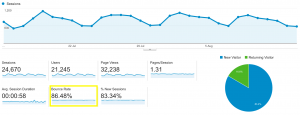- Aug 23, 2016
 0
0- by A2 Marketing Team
Your site may receive thousands of hits per day, but unless those visitors stay and engage with your content, you may as well be managing a shop with lots of browsers and not a single buyer.
Some of those people may have never been interested in your content to begin with, while others may have been put off due to some aspect of your site. Reducing the numbers in this second group should be one of your top priorities.
During this article, we’ll teach you how to find out what your bounce rate is, and how you can convince visitors to stay and make themselves feel at home on your site.
What Is Bounce Rate?
To continue with the same analogy we used at the start of this article, your site’s bounce rate would be the number of people who came into your shop, briefly looked around, and then made a beeline for the exit without a second thought.
In website terms, these are the visitors who hit the Back button or close their tabs after your site loaded, without having interacted with it. A lot of factors could be at play here, including:
- Slow website load speed testing visitors’ patience.
- Poor navigation options making it difficult for visitors to find what they want.
- Shoddy design giving the wrong impression.
Before we dig deeper into these factors, let’s discuss what the acceptable ranges for bounce rates are, and how to figure out what yours is.
The average bounce rate across the web is approximately 40.5%, which may seem like quite a high number – but to be fair, people on the internet have relatively small attention spans. If your rate is higher, then you might have a serious problem on your hands. (That said, note that bounce rate can vary greatly between industries.)
To determine your site’s bounce rate, we recommend that you use Google Analytics. Setting it up is quite simple, and once it’s gathered enough data, you’ll find your bounce rate on your Overview section:
Once you have this data, it’s time to go about improving those percentages.
5 Simple Steps Towards a Lower Bounce Rate
Step 1: Reduce Loading Times
We’ve talked a lot about this topic in the past, but let us reiterate – long loading times are a surefire way to drive people away from your site. The majority of visitors expect websites to load in two seconds or less, and each second you add to that mix dramatically increases the odds they’ll bolt even after your site finishes loading.
With that in mind, WordPress CMS users might want to take a look at our piece on 8 Top WordPress Plugins that Will Improve Website Speed, while everyone else would do well to check out Speed Matters: 7 Ways to Turbocharge Your Site.
Finally, we don’t mean to brag, but A2 Hosting consistently ranks as the fastest hosting provider when it comes to loading times.
Step 2: Guide Readers Towards Related Content
If you’re anything like us, your time online is spent bouncing from site to site, spending a few minutes on each until you’ve found the content you want, and then you’re on to the next. Spend too little time on a site or fail to interact with it, and up goes its bounce rate.
There are two simple steps you can take to prevent this from occurring in your site:
- Guide readers to related content – to entice them into staying longer – using a ‘Related Posts’ section. Implementing such a section is child’s play if you’re a WordPress user.
- Include more internal links within your posts to guide visitors towards relevant content that will provide them with useful information.
Step 3: Streamline Your Navigation
Another aspect that can impact whether your visitors find the content they want is how your navigation is set up. A confusing navigational layout – such as a hidden navigational bar or the lack of a search function – is guaranteed to cause headaches for your visitors, since they won’t be able to make their way around your site easily.
You’d think this wouldn’t be an issue since common sense dictates that every website should be designed with ease of use in mind, but you’d be surprised at how often design sensibilities trump common sense. To avoid this simple pitfall, make sure that your navigational bar – and sidebars – are simple to locate and use, and include links to all the main pages of your site therein.
Step 4: Improve Your Blog Post Structure
Although this step is mainly aimed towards those of you running blogs, the advice we’ll be doling out applies to any piece of written content.
When you’re writing for the web, structure can be just as important as the quality of the content itself as far as visitors are concerned. A lot of them may be reading your content from a mobile device – or may simply have short attention spans – and making your content easily digestible is key to improving their overall experience.
When it comes to structure, we are big fans of employing three simple techniques:
- Use relevant subheadings to break down long posts and reap the SEO benefits.
- Include lists when possible to get your point across more succinctly (case in point!).
- Insert relevant images and videos when possible to provide visual cues for your readers.
Step 5: Target the Right Audience
It’s not an easy thing to admit for most of us, but we need to be honest – some people simply aren’t interested in our sites or the kind of content we provide. There’s no reason to take this personally – after all, everybody has their own interests – and that’s why the smart thing to do is focus your efforts on targeting the right audience.
For example, the right audience for us would be best described as webmasters interested in their hosting options. Knowing this enables us to make a concerted effort to target the right keywords and reduce ‘low-quality’ traffic by taking low-performing keywords out of the equation.
Once you’ve determined what your dream audience is and made an effort to target them, all that’s left is to engage them – interact with them through social media as well as your comments section, and you’ll have loyal visitors in no time.
Conclusion
Lowering your bounce rates is a process that involves the implementation of several – mostly simple – tweaks, but the rewards can be enormous. If you can successfully target this group of users and convince them to give your site a chance, you’ll be well on your way to building a sizable and loyal audience.
To do so, start by implementing the simple fixes we discussed in this article:
- Reduce your loading times.
- Present visitors with related content.
- Streamline your navigation.
- Improve your blog post structure.
- Focus your efforts on the right audience.
What’s your favorite tool or tip to reduce bounce rates? Share your expertise with us in the comments section below!
Image credit: Pixabay.














